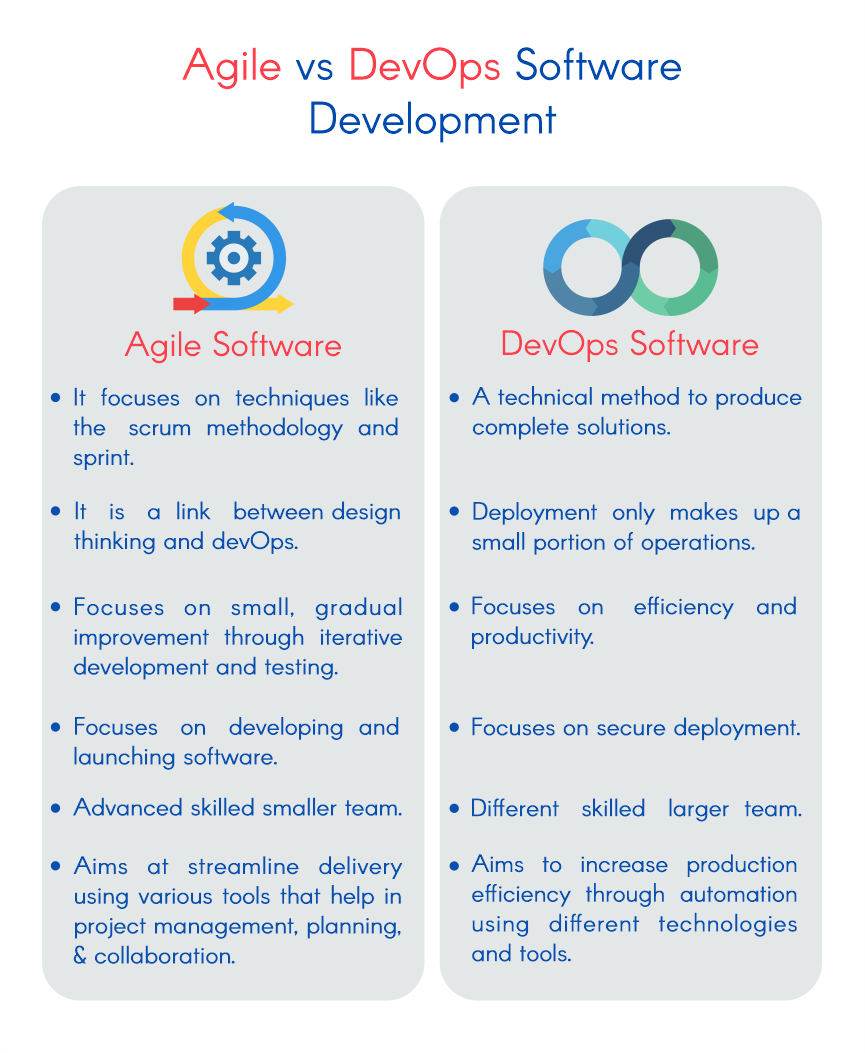Agile vs DevOps: Which One to Choose For Software Development
There are many software development methodologies available, including the waterfall model and the iterative development model. However, two methodologies, namely DevOps and Agile, are becoming more popular these days. DevOps and Agile are both essential. It makes the development process efficient. Before determining how Agile and DevOps differ from one another, we must first understand what they are. Agile methodology is a development approach that anticipates the need for flexibility and applies a certain amount of pragmatism to the delivery of the finished product. The term "DevOps" refers to the blending of cultural ideals, techniques, and tools. However, they differ in their methodologies, the groups and departments they include, and the way their production is organized. The main distinction between DevOps and Agile is that they do not have to be mutually exclusive. In DevOps culture, all teams engage in the creation, whereas the case is not the same in Agile. In today's blog post, we'll discover the differences between Agile and DevOps software development.
What is Agile?
Agile follows an iterative approach for project management and software development, which helps to provide value to their clients faster and with fewer difficulties. The best thing about Agile is it evaluates the results regularly due to which it produces work in manageable and short chunks. Agile teams have a built-in mechanism for fast responding to change. The lifecycle of Agile software: In Agile software life cycle, a product travels through a structured sequence of steps as it develops from scratch to end. The life cycle includes:
- Plan
- Design
- Develop
- Test
- Deploy
- Review
- Launch
Significant features of agile
Fulfills the requirements of the customer: Agile puts the needs of the client first. The Agile software methodology has a mindset of "fail-fast, fail-early", due to which it provides a consistent feedback loop. Therefore, it gives better results than conventional development methodologies.
More efficient: Agile helps to achieve a regular development cycle as it uses sprints or other time-boxed production techniques. Therefore, agility helps to complete tasks quickly.
Productivity tools for work flows: The well-known agile planning tools Kanban, Scrum, and others help manage work by organizing requirements, tasks, and progress.
What is DevOps?
"DevOps" refers to the combination of cultural beliefs, methods, and resources. The ability of a company to deploy apps and services quickly is improved through DevOps. Products generated by DevOps evolve and improve more quickly in comparison with conventional software development. The lifecycle of DevOps includes: Without understanding the stages of the DevOps lifecycle, learning DevOps is incomplete. The steps of the DevOps lifecycle are listed below.
- Continuous Development
- Continuous Testing
- Continuous Integration
- Continuous Deployment
- Continuous Monitoring
Significant features of DevOps
Automated systems' efficiency: In order to increase productivity, the DevOps practice looks for possibilities to develop programmable processes and automate activities.
Increased focus and reach: DevOps handles all phases of software development and delivery, aiming to speed up and improve the reliability of releases.
Interdisciplinary teamwork: DevOps provides an enhanced work environment that result in more productive teams. Therefore, it helps to decrease conflict and encourage cross-functional cooperation.
Difference between Agile and DevOps software development.

Relationship between DevOps and Agile
Agile is a very strong software development methodology which uses tools like Scrum and Kanban. Agile is the best way to organize work more efficiently. However, the tools used by DevOps are Docker, Puppet, Apache Maven, Gradle, etc. The major similarity between Agile and DevOps is that they both provide structure and framework, due to which work can be done in much less time and with minimum errors. Now, the question arises, "Can we use both Agile and DevOps together? Definitely yes! You do not have to choose between the two methodologies; instead, you can use both. To combine these two approaches, virtualization is a technological solution.
Conclusion
Agile and DevOps share the same objective, which is to increase the efficiency and quality of development. In DevOps, all teams engage in creation; the developers, the operations, and the quality assurance professionals. With Agile, it is very focused on development and then quality assurance. Operations and deployments are very focused in DevOps. As a business owner, you want to make sure that you are getting the most out of every investment. One way to do this is to make sure that you are working with a team that understands both Agile and DevOps methodologies. Agile and DevOps are becoming more and more popular, but they are often used in different situations. Knowing what you need from your team is vital to your business's success. Get in touch with expert developers of Career IT and Business Solutions Inc., a renowned custom software development company in Edmonton, Canada.
